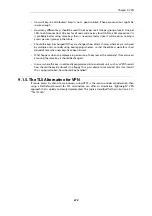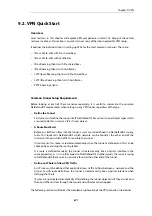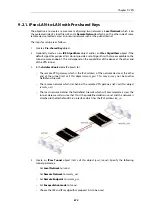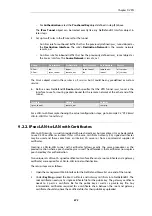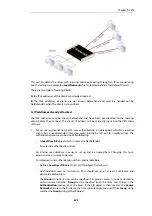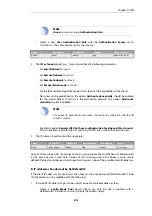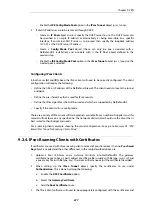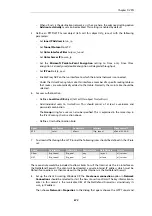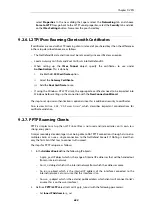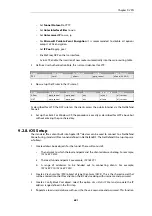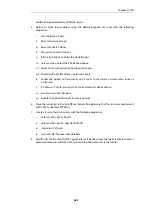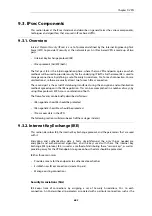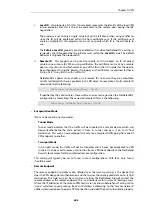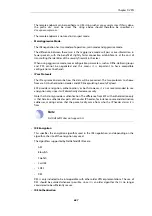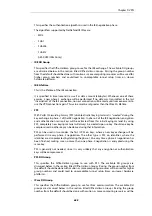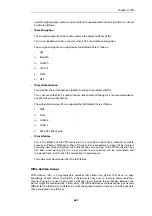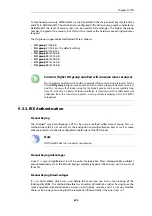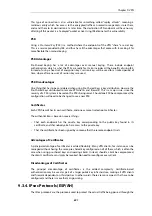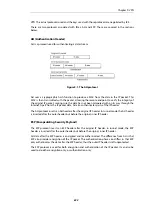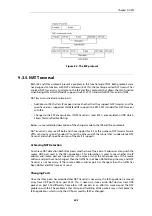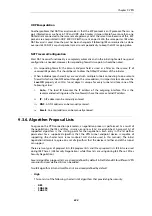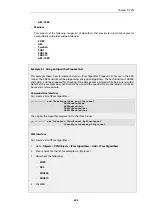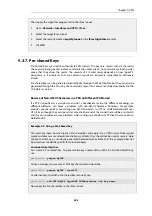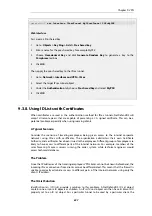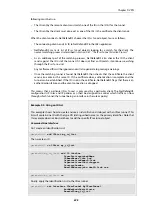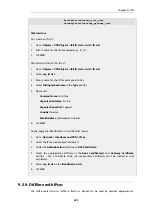
IPsec protocol used (ESP/AH/both) as well as the session keys used to encrypt/decrypt and/or
authenticate/verify the transmitted data.
An SA is unidirectional and relates to traffic flow in one direction only. For the bidirectional traffic
that is usually found in a VPN, there is therefore a need for more than one SA per connection. In
most cases, where only one of ESP or AH is used, two SAs will be created for each connection,
one describing the incoming traffic, and the other the outgoing. In cases where ESP and AH are
used in conjunction, four SAs will be created.
IKE Negotiation
The process of negotiating session parameters consists of a number of phases and modes. These
are described in detail in the sections below.
The flow of events can be summarized as follows:
IKE Phase-1
•
Negotiate how IKE should be protected
IKE Phase-2
•
Negotiate how IPsec should be protected
•
Derive some fresh keying material from the key exchange in phase-1, to
provide session keys to be used in the encryption and authentication of
the VPN data flow
IKE and IPsec Lifetimes
Both the IKE and the IPsec connections have limited lifetimes, described both in terms of time
(seconds), and data (kilobytes). These lifetimes prevent a connection from being used too long,
which is desirable from a crypto-analysis perspective.
The IPsec lifetime must be shorter than the IKE lifetime. The difference between the two must be
a minimum of 5 minutes. This allows for the IPsec connection to be re-keyed simply by
performing another phase-2 negotiation. There is no need to do another phase-1 negotiation
until the IKE lifetime has expired.
IKE Algorithm Proposals
An IKE
algorithm proposal list
is a suggestion of how to protect IPsec data flows. The VPN device
initiating an IPsec connection will send a list of the algorithms combinations it supports for
protecting the connection and it is then up to the device at the other end of the connection to
say which proposal is acceptable.
The responding VPN device, upon receiving the list of supported algorithms, will choose the
algorithm combination that best matches its own security policies, and reply by specifying which
member of the list it has chosen. If no mutually acceptable proposal can be found, the responder
will reply by saying that nothing on the list was acceptable, and possibly also provide a textual
explanation for diagnostic purposes.
This negotiation to find a mutually acceptable algorithm combination is done not just to find the
best way to protect the IPsec connection but also to find the best way to protect the IKE
negotiation itself.
Algorithm proposal lists contain not just the acceptable algorithm combinations for encrypting
and authenticating data but also other IKE related parameters. Further details of the IKE
negotiation and the other IKE parameters are described next.
Chapter 9: VPN
684
Содержание NetDefendOS
Страница 30: ...Figure 1 3 Packet Flow Schematic Part III Chapter 1 NetDefendOS Overview 30 ...
Страница 32: ...Chapter 1 NetDefendOS Overview 32 ...
Страница 144: ...Chapter 2 Management and Maintenance 144 ...
Страница 220: ... Enable DHCP passthrough Enable L2 passthrough for non IP protocols 4 Click OK Chapter 3 Fundamentals 220 ...
Страница 267: ... SourceNetwork lannet DestinationInterface any DestinationNetwork all nets 4 Click OK Chapter 3 Fundamentals 267 ...
Страница 284: ...Chapter 3 Fundamentals 284 ...
Страница 360: ...The ospf command options are fully described in the separate NetDefendOS CLI Reference Guide Chapter 4 Routing 360 ...
Страница 392: ...Chapter 4 Routing 392 ...
Страница 396: ...Web Interface 1 Go to Network Ethernet If1 2 Select Enable DHCP 3 Click OK Chapter 5 DHCP Services 396 ...
Страница 419: ... Host 2001 DB8 1 MAC 00 90 12 13 14 15 5 Click OK Chapter 5 DHCP Services 419 ...
Страница 420: ...Chapter 5 DHCP Services 420 ...
Страница 424: ...2 Now enter Name lan_Access Action Expect Interface lan Network lannet 3 Click OK Chapter 6 Security Mechanisms 424 ...
Страница 573: ...Chapter 6 Security Mechanisms 573 ...
Страница 575: ...This section describes and provides examples of configuring NAT and SAT rules Chapter 7 Address Translation 575 ...
Страница 607: ...Chapter 7 Address Translation 607 ...
Страница 666: ...Chapter 8 User Authentication 666 ...
Страница 775: ...Chapter 9 VPN 775 ...
Страница 819: ...Chapter 10 Traffic Management 819 ...
Страница 842: ...Chapter 11 High Availability 842 ...
Страница 866: ...Default Enabled Chapter 13 Advanced Settings 866 ...
Страница 879: ...Chapter 13 Advanced Settings 879 ...

